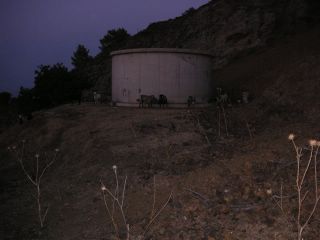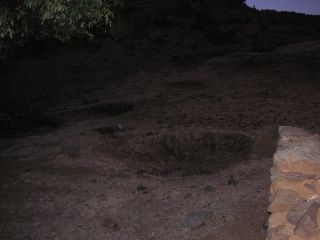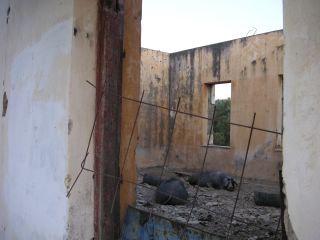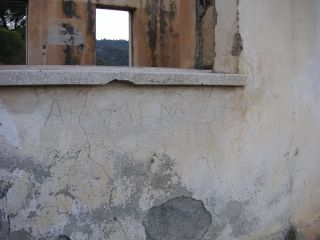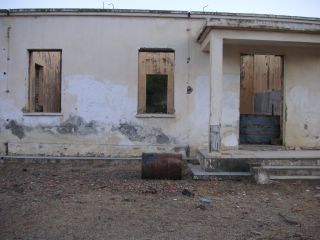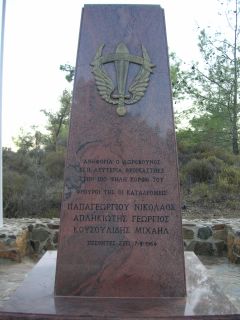I decided to officially archive this blog on the day my DPhil was confirmed. But I have waited for the electronic publication of my thesis, Interrogating Archaeological Ethics in Conflict Zones: Cultural Heritage Work in Cyprus, to announce the archiving. From now on, I will blog at Conflict Antiquities.
Saturday, August 27, 2011
Wednesday, December 16, 2009
Mansoura: abandoned village, occupied
[Thanks to Dave S's comment on the Evretou photo blog, I will try to give each site photo blog a proper introduction; until then, I'll cross-post the introductory posts from Cultural Heritage in Conflict (or samarkeolog).]
This photograph [Mansoura fountain 2a] is of one of two public fountains, those two of what appeared to be few remaining structures from the now-occupied site of the abandoned village of Mansoura.
Although it's difficult to see, as I found the site at dusk, the stacks of stones around the fountain are, or were, walls, the rooms they formed now only figments of the imagination, conjured up from the floor plan they have preserved.
Having driven through Alevga, on the 22nd of August 2006, at first, I drove past this former village, dismissing the beautiful patterns of ruddy rock that I saw out of the corner of my eye as natural.
It was only after I saw the skeleton of a building and a fountain painted in copper and green, then checked with the locally-stationed United Nations Force in Cyprus (UNFICYP) peacekeepers that I returned and was struck by them.
According to the UN peacekeepers, this is what Dubin's (2005: 204) Rough Guide to Cyprus noted as "ex-Turkish-Cypriot Mansoura" (Dubin, 2005: 204), though the "houses finally being renovated by squatters as weekend retreats", were nowhere in evidence, which makes me worry that this was only a small part of the settlement or, worse, a few, outlying buildings away from the village itself, but having driven past and walked around, I didn't see anything else.
The skeleton of a building was being used as a pig pen and a canvas for a billboard advertising Riviera Swimming Pools Ltd, its walls still plastered, but pock-marked with what seem to be bullet holes, the surrounding land covered in broken tiles, burned-out barrels and a few discarded shoes (those, presumably, recently deposited).
In the Historical Toponymy of Cyprus, Jack C. Goodwin (1978: 544) identified Mansoura as a "former village", noting that "most of the inhabitants here were linobambakoi... from the 16th Cent [Sixteenth Century] through the first part of the present Cent [Twentieth Century]".
The village had a population of about 147 - 20 Greek Cypriots and 127 Turkish Cypriots - by and until the 1960s, but, as Goodwin (1978: 544) narrated:
[This was originally posted on samarkeolog on 19th October 2006.]
[Thanks to Dave S's comment on the Evretou photo blog, I will try to give each site photo blog a proper introduction; until then, I'll cross-post the introductory posts from Cultural Heritage in Conflict (or samarkeolog).]
This photograph [Mansoura fountain 2a] is of one of two public fountains, those two of what appeared to be few remaining structures from the now-occupied site of the abandoned village of Mansoura.
Although it's difficult to see, as I found the site at dusk, the stacks of stones around the fountain are, or were, walls, the rooms they formed now only figments of the imagination, conjured up from the floor plan they have preserved.
Having driven through Alevga, on the 22nd of August 2006, at first, I drove past this former village, dismissing the beautiful patterns of ruddy rock that I saw out of the corner of my eye as natural.
It was only after I saw the skeleton of a building and a fountain painted in copper and green, then checked with the locally-stationed United Nations Force in Cyprus (UNFICYP) peacekeepers that I returned and was struck by them.
According to the UN peacekeepers, this is what Dubin's (2005: 204) Rough Guide to Cyprus noted as "ex-Turkish-Cypriot Mansoura" (Dubin, 2005: 204), though the "houses finally being renovated by squatters as weekend retreats", were nowhere in evidence, which makes me worry that this was only a small part of the settlement or, worse, a few, outlying buildings away from the village itself, but having driven past and walked around, I didn't see anything else.
The skeleton of a building was being used as a pig pen and a canvas for a billboard advertising Riviera Swimming Pools Ltd, its walls still plastered, but pock-marked with what seem to be bullet holes, the surrounding land covered in broken tiles, burned-out barrels and a few discarded shoes (those, presumably, recently deposited).
In the Historical Toponymy of Cyprus, Jack C. Goodwin (1978: 544) identified Mansoura as a "former village", noting that "most of the inhabitants here were linobambakoi... from the 16th Cent [Sixteenth Century] through the first part of the present Cent [Twentieth Century]".
The village had a population of about 147 - 20 Greek Cypriots and 127 Turkish Cypriots - by and until the 1960s, but, as Goodwin (1978: 544) narrated:
Mansoura was abandoned in 1964 because of intercommunal fighting, UNFICYP escorting the civilians out in Aug [August] of that yr [year]. The vill [village] was inherited by the UN & has since been in No Man's Land (at the NE [north-east] edge of the T [Turkish/Turkish Cypriot] Kokkina enclave, its houses derelict & falling down.This fountain and the other were both built in 1957; they must have been some of the last, public goods established in the community before it was torn apart by the nationalists' violence.
[This was originally posted on samarkeolog on 19th October 2006.]
Wednesday, March 14, 2007
Mansoura in nationalist history education
I don't know where to put this for the moment, but Mansoura's mentioned in "a study of clashes in Dillirga and how they were reflected in official annals", by Ulus Irkad, which reviews both Greek Cypriot and Turkish Cypriot school textbooks and, unsurprisingly, finds that they're nationalist texts.
It's from a book about history education, human rights and understanding produced by the New Cyprus Party (Κόμμα Νέα Κύπρος or Υeni Kıbrıs Partisi). Irkad's article is worth reading in full, but the key to his evaluation is this:
I don't know where to put this for the moment, but Mansoura's mentioned in "a study of clashes in Dillirga and how they were reflected in official annals", by Ulus Irkad, which reviews both Greek Cypriot and Turkish Cypriot school textbooks and, unsurprisingly, finds that they're nationalist texts.
It's from a book about history education, human rights and understanding produced by the New Cyprus Party (Κόμμα Νέα Κύπρος or Υeni Kıbrıs Partisi). Irkad's article is worth reading in full, but the key to his evaluation is this:
Both sides in this conflict try to induce the impression of their innocence stressing the pressure on them. As always the guilty side is the other one.... Both communities endeavour to conceal the facts from their communities showing the other side as culprits in this affair....
If the events and developments that took place in Dillirga are rightly reflected and recorded in textbooks indicating mishaps I tried to stress above, the forthcoming generations will have a better chance to understand all that happened . They can thus try to avoid the recurrence of similar incidence in the future.
Thursday, November 30, 2006
Subscribe to:
Comments (Atom)


